Essay on Mental Health Care, Human Rights, Social Justice in Australia
VerifiedAdded on 2022/08/20
|11
|2861
|16
Essay
AI Summary
This essay provides a comprehensive overview of mental health care in Australia, emphasizing the interplay between human rights, social justice, and social policy. The essay begins by defining health and mental health, and then explores the conceptualization of mental health and mental illness within the context of human rights. It examines the current state of mental health services in Australia, including government funding, the role of Medicare, and the specific challenges faced by Aboriginal and Torres Strait Islander peoples. The essay delves into mental health legislation, including the Disability Discrimination Act 1992 and the National Mental Health Strategy, highlighting the evolution of policies aimed at protecting the rights of individuals with mental illness. The essay then analyzes gaps in service delivery and proposes two potential solutions from a social work perspective, drawing on observations, readings, and experiences. The essay concludes by highlighting the need for improved funding and resources to address the growing mental health crisis in Australia, ensuring equitable access to care and the prevention of discrimination.
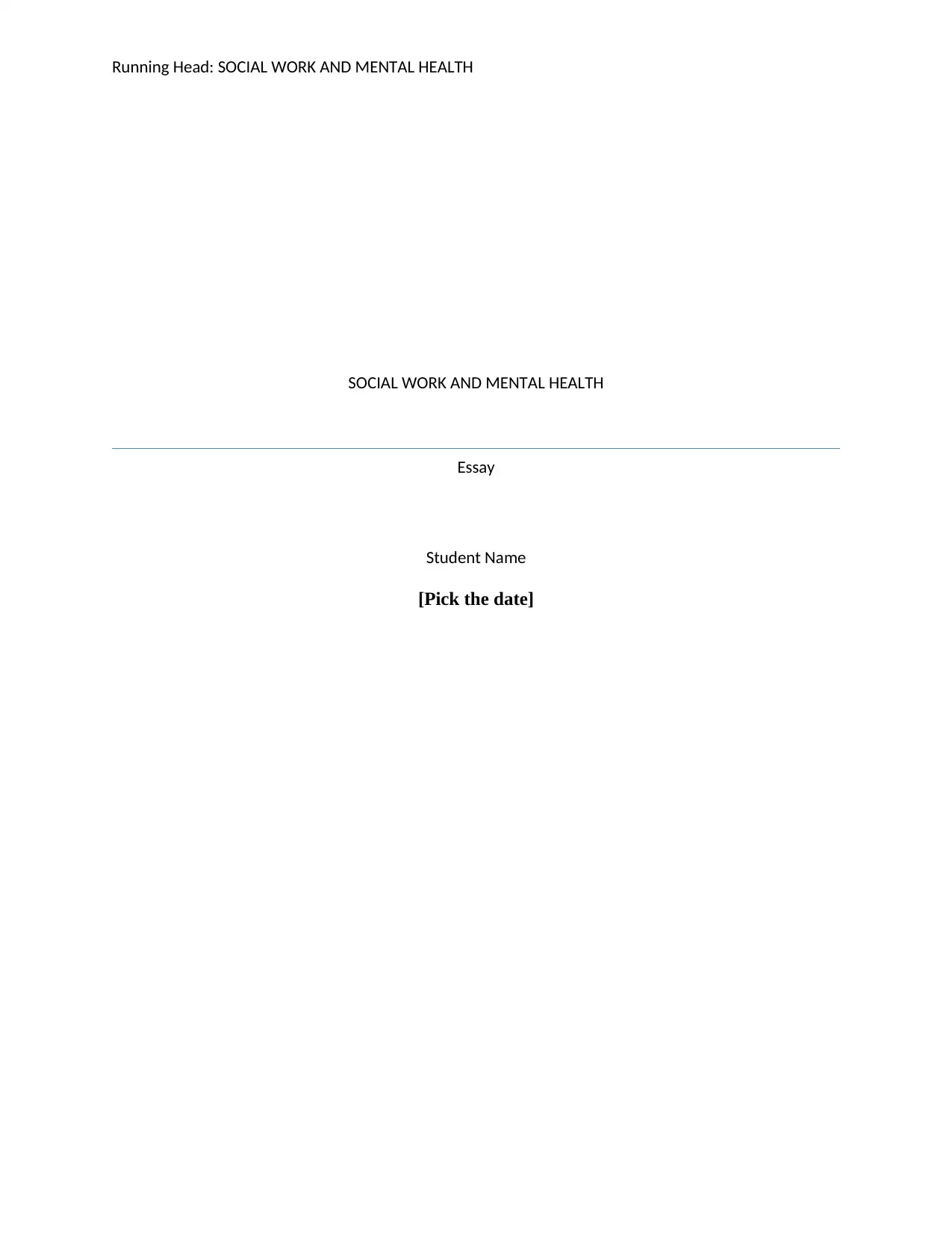
Running Head: SOCIAL WORK AND MENTAL HEALTH
SOCIAL WORK AND MENTAL HEALTH
Essay
Student Name
[Pick the date]
SOCIAL WORK AND MENTAL HEALTH
Essay
Student Name
[Pick the date]
Paraphrase This Document
Need a fresh take? Get an instant paraphrase of this document with our AI Paraphraser
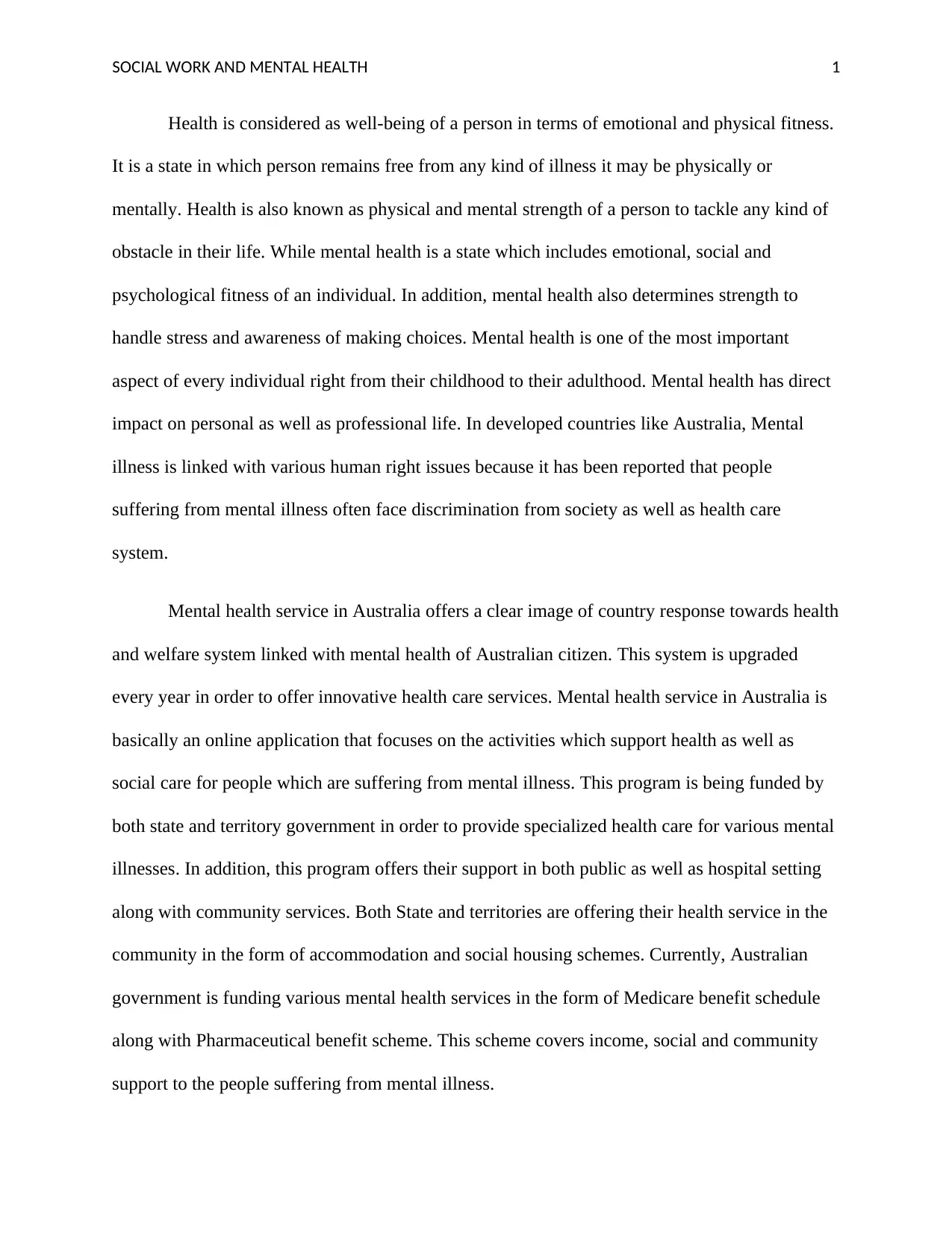
SOCIAL WORK AND MENTAL HEALTH 1
Health is considered as well-being of a person in terms of emotional and physical fitness.
It is a state in which person remains free from any kind of illness it may be physically or
mentally. Health is also known as physical and mental strength of a person to tackle any kind of
obstacle in their life. While mental health is a state which includes emotional, social and
psychological fitness of an individual. In addition, mental health also determines strength to
handle stress and awareness of making choices. Mental health is one of the most important
aspect of every individual right from their childhood to their adulthood. Mental health has direct
impact on personal as well as professional life. In developed countries like Australia, Mental
illness is linked with various human right issues because it has been reported that people
suffering from mental illness often face discrimination from society as well as health care
system.
Mental health service in Australia offers a clear image of country response towards health
and welfare system linked with mental health of Australian citizen. This system is upgraded
every year in order to offer innovative health care services. Mental health service in Australia is
basically an online application that focuses on the activities which support health as well as
social care for people which are suffering from mental illness. This program is being funded by
both state and territory government in order to provide specialized health care for various mental
illnesses. In addition, this program offers their support in both public as well as hospital setting
along with community services. Both State and territories are offering their health service in the
community in the form of accommodation and social housing schemes. Currently, Australian
government is funding various mental health services in the form of Medicare benefit schedule
along with Pharmaceutical benefit scheme. This scheme covers income, social and community
support to the people suffering from mental illness.
Health is considered as well-being of a person in terms of emotional and physical fitness.
It is a state in which person remains free from any kind of illness it may be physically or
mentally. Health is also known as physical and mental strength of a person to tackle any kind of
obstacle in their life. While mental health is a state which includes emotional, social and
psychological fitness of an individual. In addition, mental health also determines strength to
handle stress and awareness of making choices. Mental health is one of the most important
aspect of every individual right from their childhood to their adulthood. Mental health has direct
impact on personal as well as professional life. In developed countries like Australia, Mental
illness is linked with various human right issues because it has been reported that people
suffering from mental illness often face discrimination from society as well as health care
system.
Mental health service in Australia offers a clear image of country response towards health
and welfare system linked with mental health of Australian citizen. This system is upgraded
every year in order to offer innovative health care services. Mental health service in Australia is
basically an online application that focuses on the activities which support health as well as
social care for people which are suffering from mental illness. This program is being funded by
both state and territory government in order to provide specialized health care for various mental
illnesses. In addition, this program offers their support in both public as well as hospital setting
along with community services. Both State and territories are offering their health service in the
community in the form of accommodation and social housing schemes. Currently, Australian
government is funding various mental health services in the form of Medicare benefit schedule
along with Pharmaceutical benefit scheme. This scheme covers income, social and community
support to the people suffering from mental illness.
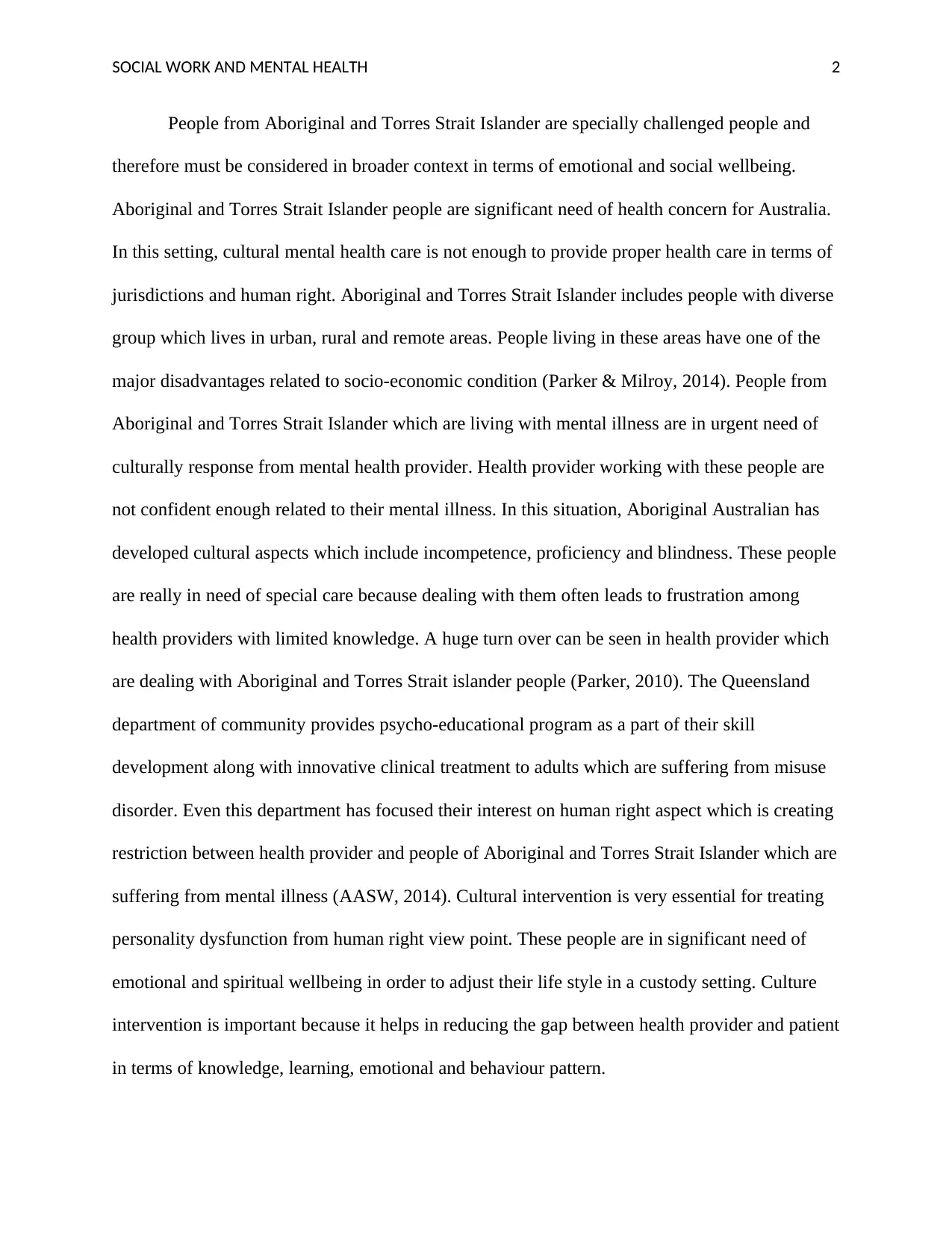
SOCIAL WORK AND MENTAL HEALTH 2
People from Aboriginal and Torres Strait Islander are specially challenged people and
therefore must be considered in broader context in terms of emotional and social wellbeing.
Aboriginal and Torres Strait Islander people are significant need of health concern for Australia.
In this setting, cultural mental health care is not enough to provide proper health care in terms of
jurisdictions and human right. Aboriginal and Torres Strait Islander includes people with diverse
group which lives in urban, rural and remote areas. People living in these areas have one of the
major disadvantages related to socio-economic condition (Parker & Milroy, 2014). People from
Aboriginal and Torres Strait Islander which are living with mental illness are in urgent need of
culturally response from mental health provider. Health provider working with these people are
not confident enough related to their mental illness. In this situation, Aboriginal Australian has
developed cultural aspects which include incompetence, proficiency and blindness. These people
are really in need of special care because dealing with them often leads to frustration among
health providers with limited knowledge. A huge turn over can be seen in health provider which
are dealing with Aboriginal and Torres Strait islander people (Parker, 2010). The Queensland
department of community provides psycho-educational program as a part of their skill
development along with innovative clinical treatment to adults which are suffering from misuse
disorder. Even this department has focused their interest on human right aspect which is creating
restriction between health provider and people of Aboriginal and Torres Strait Islander which are
suffering from mental illness (AASW, 2014). Cultural intervention is very essential for treating
personality dysfunction from human right view point. These people are in significant need of
emotional and spiritual wellbeing in order to adjust their life style in a custody setting. Culture
intervention is important because it helps in reducing the gap between health provider and patient
in terms of knowledge, learning, emotional and behaviour pattern.
People from Aboriginal and Torres Strait Islander are specially challenged people and
therefore must be considered in broader context in terms of emotional and social wellbeing.
Aboriginal and Torres Strait Islander people are significant need of health concern for Australia.
In this setting, cultural mental health care is not enough to provide proper health care in terms of
jurisdictions and human right. Aboriginal and Torres Strait Islander includes people with diverse
group which lives in urban, rural and remote areas. People living in these areas have one of the
major disadvantages related to socio-economic condition (Parker & Milroy, 2014). People from
Aboriginal and Torres Strait Islander which are living with mental illness are in urgent need of
culturally response from mental health provider. Health provider working with these people are
not confident enough related to their mental illness. In this situation, Aboriginal Australian has
developed cultural aspects which include incompetence, proficiency and blindness. These people
are really in need of special care because dealing with them often leads to frustration among
health providers with limited knowledge. A huge turn over can be seen in health provider which
are dealing with Aboriginal and Torres Strait islander people (Parker, 2010). The Queensland
department of community provides psycho-educational program as a part of their skill
development along with innovative clinical treatment to adults which are suffering from misuse
disorder. Even this department has focused their interest on human right aspect which is creating
restriction between health provider and people of Aboriginal and Torres Strait Islander which are
suffering from mental illness (AASW, 2014). Cultural intervention is very essential for treating
personality dysfunction from human right view point. These people are in significant need of
emotional and spiritual wellbeing in order to adjust their life style in a custody setting. Culture
intervention is important because it helps in reducing the gap between health provider and patient
in terms of knowledge, learning, emotional and behaviour pattern.
⊘ This is a preview!⊘
Do you want full access?
Subscribe today to unlock all pages.

Trusted by 1+ million students worldwide
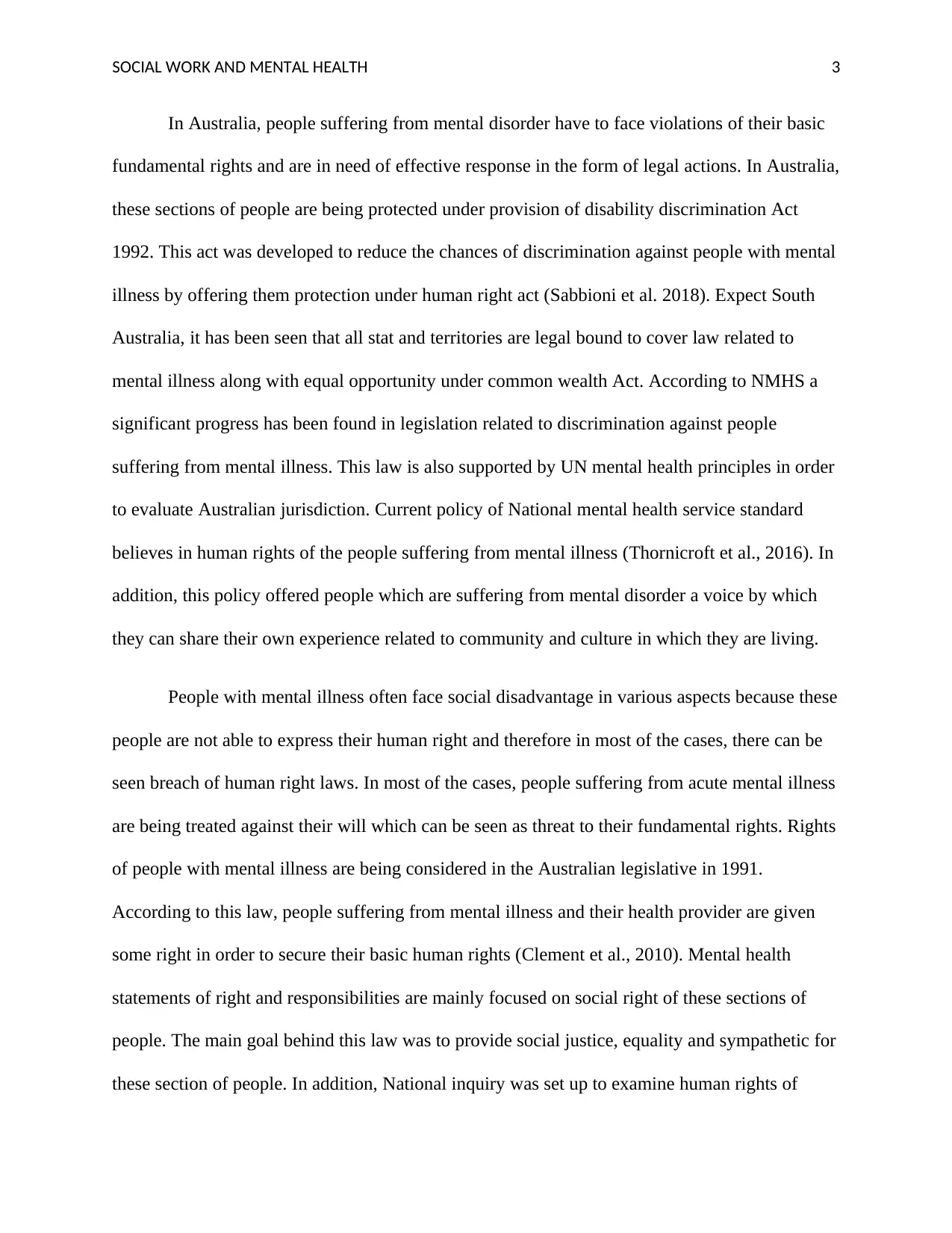
SOCIAL WORK AND MENTAL HEALTH 3
In Australia, people suffering from mental disorder have to face violations of their basic
fundamental rights and are in need of effective response in the form of legal actions. In Australia,
these sections of people are being protected under provision of disability discrimination Act
1992. This act was developed to reduce the chances of discrimination against people with mental
illness by offering them protection under human right act (Sabbioni et al. 2018). Expect South
Australia, it has been seen that all stat and territories are legal bound to cover law related to
mental illness along with equal opportunity under common wealth Act. According to NMHS a
significant progress has been found in legislation related to discrimination against people
suffering from mental illness. This law is also supported by UN mental health principles in order
to evaluate Australian jurisdiction. Current policy of National mental health service standard
believes in human rights of the people suffering from mental illness (Thornicroft et al., 2016). In
addition, this policy offered people which are suffering from mental disorder a voice by which
they can share their own experience related to community and culture in which they are living.
People with mental illness often face social disadvantage in various aspects because these
people are not able to express their human right and therefore in most of the cases, there can be
seen breach of human right laws. In most of the cases, people suffering from acute mental illness
are being treated against their will which can be seen as threat to their fundamental rights. Rights
of people with mental illness are being considered in the Australian legislative in 1991.
According to this law, people suffering from mental illness and their health provider are given
some right in order to secure their basic human rights (Clement et al., 2010). Mental health
statements of right and responsibilities are mainly focused on social right of these sections of
people. The main goal behind this law was to provide social justice, equality and sympathetic for
these section of people. In addition, National inquiry was set up to examine human rights of
In Australia, people suffering from mental disorder have to face violations of their basic
fundamental rights and are in need of effective response in the form of legal actions. In Australia,
these sections of people are being protected under provision of disability discrimination Act
1992. This act was developed to reduce the chances of discrimination against people with mental
illness by offering them protection under human right act (Sabbioni et al. 2018). Expect South
Australia, it has been seen that all stat and territories are legal bound to cover law related to
mental illness along with equal opportunity under common wealth Act. According to NMHS a
significant progress has been found in legislation related to discrimination against people
suffering from mental illness. This law is also supported by UN mental health principles in order
to evaluate Australian jurisdiction. Current policy of National mental health service standard
believes in human rights of the people suffering from mental illness (Thornicroft et al., 2016). In
addition, this policy offered people which are suffering from mental disorder a voice by which
they can share their own experience related to community and culture in which they are living.
People with mental illness often face social disadvantage in various aspects because these
people are not able to express their human right and therefore in most of the cases, there can be
seen breach of human right laws. In most of the cases, people suffering from acute mental illness
are being treated against their will which can be seen as threat to their fundamental rights. Rights
of people with mental illness are being considered in the Australian legislative in 1991.
According to this law, people suffering from mental illness and their health provider are given
some right in order to secure their basic human rights (Clement et al., 2010). Mental health
statements of right and responsibilities are mainly focused on social right of these sections of
people. The main goal behind this law was to provide social justice, equality and sympathetic for
these section of people. In addition, National inquiry was set up to examine human rights of
Paraphrase This Document
Need a fresh take? Get an instant paraphrase of this document with our AI Paraphraser
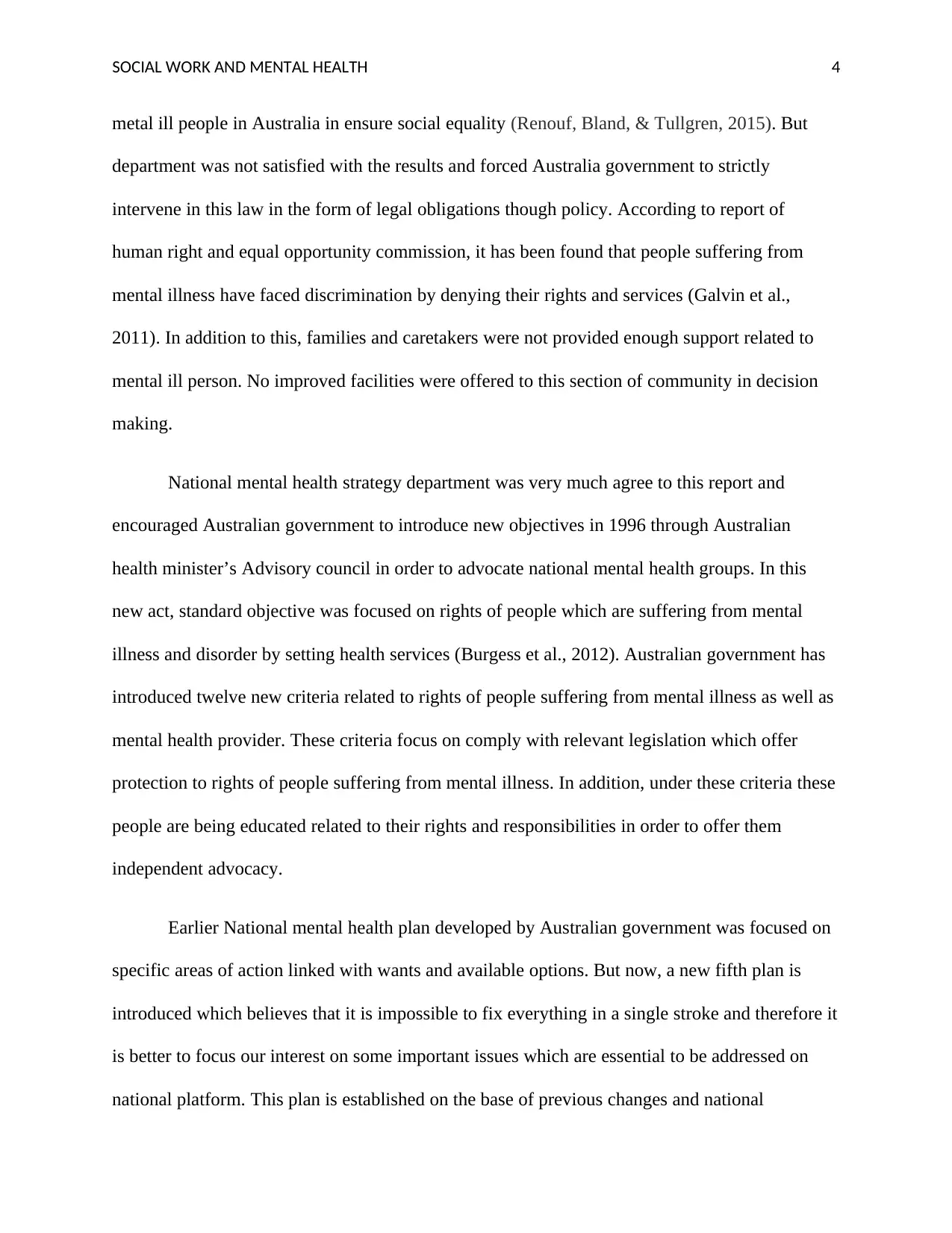
SOCIAL WORK AND MENTAL HEALTH 4
metal ill people in Australia in ensure social equality (Renouf, Bland, & Tullgren, 2015). But
department was not satisfied with the results and forced Australia government to strictly
intervene in this law in the form of legal obligations though policy. According to report of
human right and equal opportunity commission, it has been found that people suffering from
mental illness have faced discrimination by denying their rights and services (Galvin et al.,
2011). In addition to this, families and caretakers were not provided enough support related to
mental ill person. No improved facilities were offered to this section of community in decision
making.
National mental health strategy department was very much agree to this report and
encouraged Australian government to introduce new objectives in 1996 through Australian
health minister’s Advisory council in order to advocate national mental health groups. In this
new act, standard objective was focused on rights of people which are suffering from mental
illness and disorder by setting health services (Burgess et al., 2012). Australian government has
introduced twelve new criteria related to rights of people suffering from mental illness as well as
mental health provider. These criteria focus on comply with relevant legislation which offer
protection to rights of people suffering from mental illness. In addition, under these criteria these
people are being educated related to their rights and responsibilities in order to offer them
independent advocacy.
Earlier National mental health plan developed by Australian government was focused on
specific areas of action linked with wants and available options. But now, a new fifth plan is
introduced which believes that it is impossible to fix everything in a single stroke and therefore it
is better to focus our interest on some important issues which are essential to be addressed on
national platform. This plan is established on the base of previous changes and national
metal ill people in Australia in ensure social equality (Renouf, Bland, & Tullgren, 2015). But
department was not satisfied with the results and forced Australia government to strictly
intervene in this law in the form of legal obligations though policy. According to report of
human right and equal opportunity commission, it has been found that people suffering from
mental illness have faced discrimination by denying their rights and services (Galvin et al.,
2011). In addition to this, families and caretakers were not provided enough support related to
mental ill person. No improved facilities were offered to this section of community in decision
making.
National mental health strategy department was very much agree to this report and
encouraged Australian government to introduce new objectives in 1996 through Australian
health minister’s Advisory council in order to advocate national mental health groups. In this
new act, standard objective was focused on rights of people which are suffering from mental
illness and disorder by setting health services (Burgess et al., 2012). Australian government has
introduced twelve new criteria related to rights of people suffering from mental illness as well as
mental health provider. These criteria focus on comply with relevant legislation which offer
protection to rights of people suffering from mental illness. In addition, under these criteria these
people are being educated related to their rights and responsibilities in order to offer them
independent advocacy.
Earlier National mental health plan developed by Australian government was focused on
specific areas of action linked with wants and available options. But now, a new fifth plan is
introduced which believes that it is impossible to fix everything in a single stroke and therefore it
is better to focus our interest on some important issues which are essential to be addressed on
national platform. This plan is established on the base of previous changes and national

SOCIAL WORK AND MENTAL HEALTH 5
approaches in collaboration with government for almost five years. This plan includes feedback
from various stakeholders in order to introduce innovative way of offering support to section of
people which are suffering from mental illness (National mental health strategy, 2019). This plan
is focused on resolving those problems which are being faced by people suffering from mental
illness with in duration of five years by bringing reforming previous system. Often people
suffering from mental illness commit suicide and in order to prevent this situation. Collaboration
is being formed between Fifth national mental health and suicide prevention plan and National
mental health strategy. Australian health minister in conference has suite number of protection
documents (Shin & Kim, 2015). It includes national mental health policy, right and
responsibilities and national health plans in order to reform existing system for prevention of
discrimination against people with mental illness. These policies guide government to put
maximum efforts in bringing new reforms in mental health services. Objective and vision of this
policy is in the context of development on both state and national plan (Hickie et al., 2014).
National mental health policy was upgraded in 2008 by the support of all level of governments to
bring improvement in mental health results on the national level.
Due to this policy reforms, people with mental illness and their family are getting active
support from the government and are covering both state as well as territories which was not
possible earlier. This policy ensures that mental health care service must stand some standards in
order to ensure better service. In addition communities, sports clubs are being education to treat
people with mental illness with love and equality through their support. Ensure that these
sections of people are getting proper support from their family and friends. Australian
government is committed to spend around $ 80 million to offer mental health services under
National psychosocial support policy. In addition government is not limiting their support to only
approaches in collaboration with government for almost five years. This plan includes feedback
from various stakeholders in order to introduce innovative way of offering support to section of
people which are suffering from mental illness (National mental health strategy, 2019). This plan
is focused on resolving those problems which are being faced by people suffering from mental
illness with in duration of five years by bringing reforming previous system. Often people
suffering from mental illness commit suicide and in order to prevent this situation. Collaboration
is being formed between Fifth national mental health and suicide prevention plan and National
mental health strategy. Australian health minister in conference has suite number of protection
documents (Shin & Kim, 2015). It includes national mental health policy, right and
responsibilities and national health plans in order to reform existing system for prevention of
discrimination against people with mental illness. These policies guide government to put
maximum efforts in bringing new reforms in mental health services. Objective and vision of this
policy is in the context of development on both state and national plan (Hickie et al., 2014).
National mental health policy was upgraded in 2008 by the support of all level of governments to
bring improvement in mental health results on the national level.
Due to this policy reforms, people with mental illness and their family are getting active
support from the government and are covering both state as well as territories which was not
possible earlier. This policy ensures that mental health care service must stand some standards in
order to ensure better service. In addition communities, sports clubs are being education to treat
people with mental illness with love and equality through their support. Ensure that these
sections of people are getting proper support from their family and friends. Australian
government is committed to spend around $ 80 million to offer mental health services under
National psychosocial support policy. In addition government is not limiting their support to only
⊘ This is a preview!⊘
Do you want full access?
Subscribe today to unlock all pages.

Trusted by 1+ million students worldwide
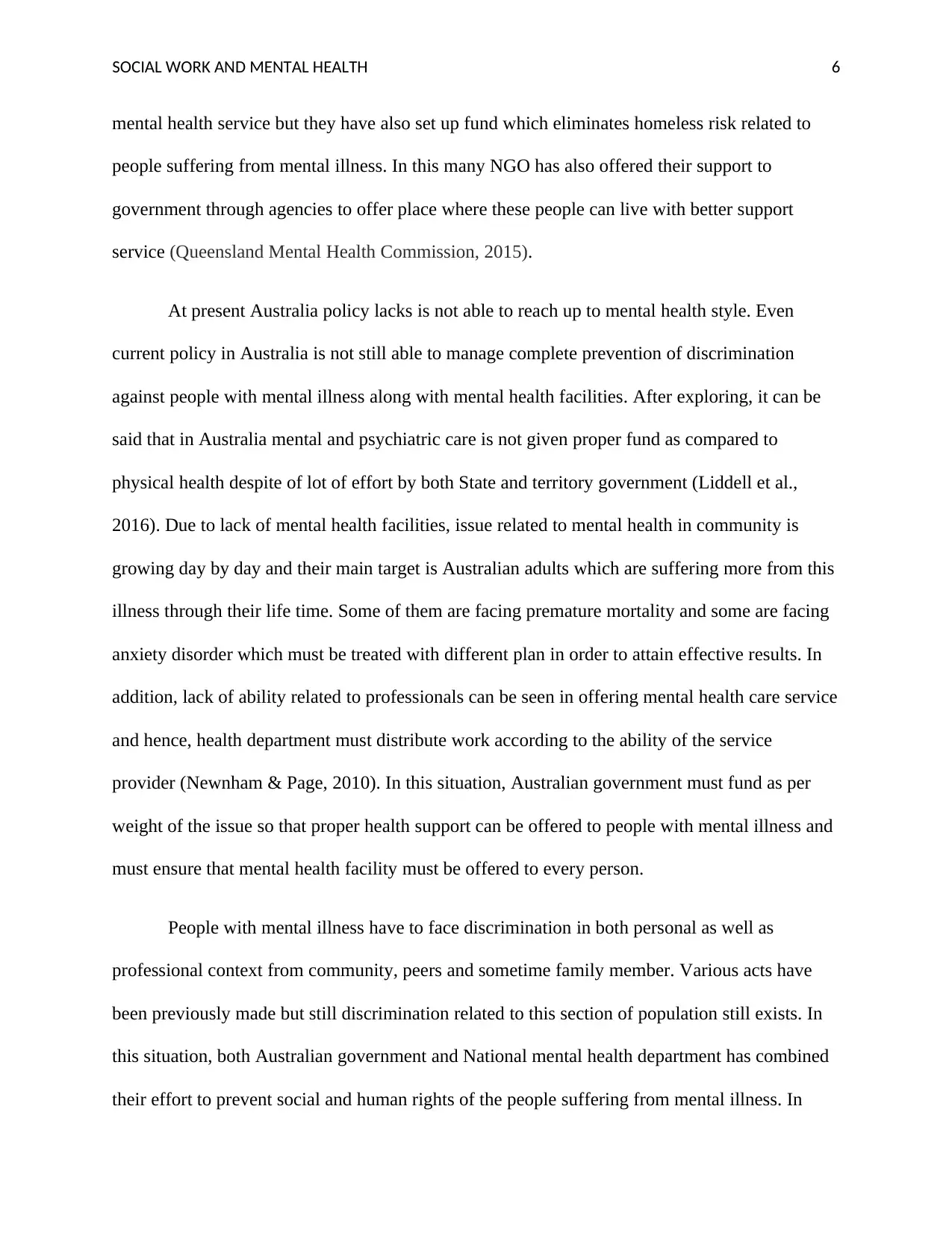
SOCIAL WORK AND MENTAL HEALTH 6
mental health service but they have also set up fund which eliminates homeless risk related to
people suffering from mental illness. In this many NGO has also offered their support to
government through agencies to offer place where these people can live with better support
service (Queensland Mental Health Commission, 2015).
At present Australia policy lacks is not able to reach up to mental health style. Even
current policy in Australia is not still able to manage complete prevention of discrimination
against people with mental illness along with mental health facilities. After exploring, it can be
said that in Australia mental and psychiatric care is not given proper fund as compared to
physical health despite of lot of effort by both State and territory government (Liddell et al.,
2016). Due to lack of mental health facilities, issue related to mental health in community is
growing day by day and their main target is Australian adults which are suffering more from this
illness through their life time. Some of them are facing premature mortality and some are facing
anxiety disorder which must be treated with different plan in order to attain effective results. In
addition, lack of ability related to professionals can be seen in offering mental health care service
and hence, health department must distribute work according to the ability of the service
provider (Newnham & Page, 2010). In this situation, Australian government must fund as per
weight of the issue so that proper health support can be offered to people with mental illness and
must ensure that mental health facility must be offered to every person.
People with mental illness have to face discrimination in both personal as well as
professional context from community, peers and sometime family member. Various acts have
been previously made but still discrimination related to this section of population still exists. In
this situation, both Australian government and National mental health department has combined
their effort to prevent social and human rights of the people suffering from mental illness. In
mental health service but they have also set up fund which eliminates homeless risk related to
people suffering from mental illness. In this many NGO has also offered their support to
government through agencies to offer place where these people can live with better support
service (Queensland Mental Health Commission, 2015).
At present Australia policy lacks is not able to reach up to mental health style. Even
current policy in Australia is not still able to manage complete prevention of discrimination
against people with mental illness along with mental health facilities. After exploring, it can be
said that in Australia mental and psychiatric care is not given proper fund as compared to
physical health despite of lot of effort by both State and territory government (Liddell et al.,
2016). Due to lack of mental health facilities, issue related to mental health in community is
growing day by day and their main target is Australian adults which are suffering more from this
illness through their life time. Some of them are facing premature mortality and some are facing
anxiety disorder which must be treated with different plan in order to attain effective results. In
addition, lack of ability related to professionals can be seen in offering mental health care service
and hence, health department must distribute work according to the ability of the service
provider (Newnham & Page, 2010). In this situation, Australian government must fund as per
weight of the issue so that proper health support can be offered to people with mental illness and
must ensure that mental health facility must be offered to every person.
People with mental illness have to face discrimination in both personal as well as
professional context from community, peers and sometime family member. Various acts have
been previously made but still discrimination related to this section of population still exists. In
this situation, both Australian government and National mental health department has combined
their effort to prevent social and human rights of the people suffering from mental illness. In
Paraphrase This Document
Need a fresh take? Get an instant paraphrase of this document with our AI Paraphraser

SOCIAL WORK AND MENTAL HEALTH 7
addition, this collaboration is also focused on providing innovate health services to this section
with home security especially in Aboriginal and Torres Strait Islander where mental service
facilities are very limited along with less knowledge of implementing effective plan.
addition, this collaboration is also focused on providing innovate health services to this section
with home security especially in Aboriginal and Torres Strait Islander where mental service
facilities are very limited along with less knowledge of implementing effective plan.
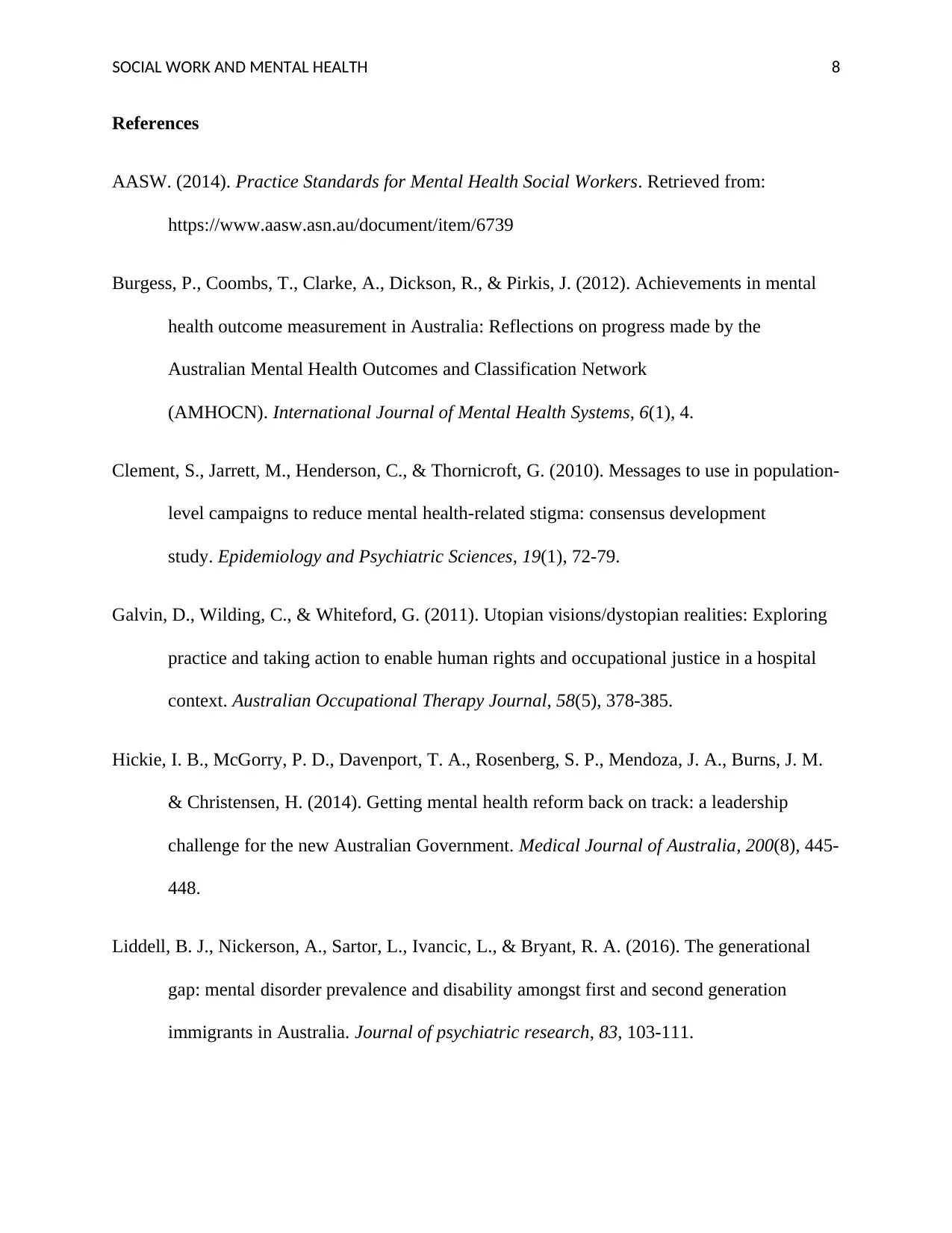
SOCIAL WORK AND MENTAL HEALTH 8
References
AASW. (2014). Practice Standards for Mental Health Social Workers. Retrieved from:
https://www.aasw.asn.au/document/item/6739
Burgess, P., Coombs, T., Clarke, A., Dickson, R., & Pirkis, J. (2012). Achievements in mental
health outcome measurement in Australia: Reflections on progress made by the
Australian Mental Health Outcomes and Classification Network
(AMHOCN). International Journal of Mental Health Systems, 6(1), 4.
Clement, S., Jarrett, M., Henderson, C., & Thornicroft, G. (2010). Messages to use in population-
level campaigns to reduce mental health-related stigma: consensus development
study. Epidemiology and Psychiatric Sciences, 19(1), 72-79.
Galvin, D., Wilding, C., & Whiteford, G. (2011). Utopian visions/dystopian realities: Exploring
practice and taking action to enable human rights and occupational justice in a hospital
context. Australian Occupational Therapy Journal, 58(5), 378-385.
Hickie, I. B., McGorry, P. D., Davenport, T. A., Rosenberg, S. P., Mendoza, J. A., Burns, J. M.
& Christensen, H. (2014). Getting mental health reform back on track: a leadership
challenge for the new Australian Government. Medical Journal of Australia, 200(8), 445-
448.
Liddell, B. J., Nickerson, A., Sartor, L., Ivancic, L., & Bryant, R. A. (2016). The generational
gap: mental disorder prevalence and disability amongst first and second generation
immigrants in Australia. Journal of psychiatric research, 83, 103-111.
References
AASW. (2014). Practice Standards for Mental Health Social Workers. Retrieved from:
https://www.aasw.asn.au/document/item/6739
Burgess, P., Coombs, T., Clarke, A., Dickson, R., & Pirkis, J. (2012). Achievements in mental
health outcome measurement in Australia: Reflections on progress made by the
Australian Mental Health Outcomes and Classification Network
(AMHOCN). International Journal of Mental Health Systems, 6(1), 4.
Clement, S., Jarrett, M., Henderson, C., & Thornicroft, G. (2010). Messages to use in population-
level campaigns to reduce mental health-related stigma: consensus development
study. Epidemiology and Psychiatric Sciences, 19(1), 72-79.
Galvin, D., Wilding, C., & Whiteford, G. (2011). Utopian visions/dystopian realities: Exploring
practice and taking action to enable human rights and occupational justice in a hospital
context. Australian Occupational Therapy Journal, 58(5), 378-385.
Hickie, I. B., McGorry, P. D., Davenport, T. A., Rosenberg, S. P., Mendoza, J. A., Burns, J. M.
& Christensen, H. (2014). Getting mental health reform back on track: a leadership
challenge for the new Australian Government. Medical Journal of Australia, 200(8), 445-
448.
Liddell, B. J., Nickerson, A., Sartor, L., Ivancic, L., & Bryant, R. A. (2016). The generational
gap: mental disorder prevalence and disability amongst first and second generation
immigrants in Australia. Journal of psychiatric research, 83, 103-111.
⊘ This is a preview!⊘
Do you want full access?
Subscribe today to unlock all pages.

Trusted by 1+ million students worldwide

SOCIAL WORK AND MENTAL HEALTH 9
National mental health strategy. (2019). The Fifth National Mental Health and Suicide
Prevention Plan [online]. Retrieved from: https://apo.org.au/sites/default/files/resource-
files/2017/10/apo-nid114356-1220416.pdf
Newnham, E. A., & Page, A. C. (2010). Bridging the gap between best evidence and best
practice in mental health. Clinical psychology review, 30(1), 127-142.
Parker, R. (2010). Australian Aboriginal and Torres Strait Islander mental health: an
overview. Working together: Aboriginal and Torres Strait Islander mental health and
wellbeing principles and practice, 3-11.
Parker, R., & Milroy, H. (2014). Aboriginal and Torres Strait Islander mental health: an
overview. Working together: Aboriginal and Torres Strait Islander mental health and
wellbeing principles and practice, 2, 25-38.
Queensland Mental Health Commission. (2015). Early action: Queensland mental health
promotion, prevention and early intervention action plan 2015-2017.
Renouf; N , Bland, R & Tullgren, A. (2015). Social work practice in mental health: An
introduction. Allen & Unwin.
Sabbioni, D., Feehan, S., Nicholls, C., Soong, W., Rigoli, D., Follett, D. & Smith, W. (2018).
Providing culturally informed mental health services to Aboriginal youth: The YouthLink
model in Western Australia. Early intervention in psychiatry, 12(5), 987-994.
Shin, C. S., & Kim, S. W. (2015). Mental Health Reform through the National Mental Health
Strategy in Australia and Convergence Policy Implications. Journal of Digital
Convergence, 13(6), 341-350.
National mental health strategy. (2019). The Fifth National Mental Health and Suicide
Prevention Plan [online]. Retrieved from: https://apo.org.au/sites/default/files/resource-
files/2017/10/apo-nid114356-1220416.pdf
Newnham, E. A., & Page, A. C. (2010). Bridging the gap between best evidence and best
practice in mental health. Clinical psychology review, 30(1), 127-142.
Parker, R. (2010). Australian Aboriginal and Torres Strait Islander mental health: an
overview. Working together: Aboriginal and Torres Strait Islander mental health and
wellbeing principles and practice, 3-11.
Parker, R., & Milroy, H. (2014). Aboriginal and Torres Strait Islander mental health: an
overview. Working together: Aboriginal and Torres Strait Islander mental health and
wellbeing principles and practice, 2, 25-38.
Queensland Mental Health Commission. (2015). Early action: Queensland mental health
promotion, prevention and early intervention action plan 2015-2017.
Renouf; N , Bland, R & Tullgren, A. (2015). Social work practice in mental health: An
introduction. Allen & Unwin.
Sabbioni, D., Feehan, S., Nicholls, C., Soong, W., Rigoli, D., Follett, D. & Smith, W. (2018).
Providing culturally informed mental health services to Aboriginal youth: The YouthLink
model in Western Australia. Early intervention in psychiatry, 12(5), 987-994.
Shin, C. S., & Kim, S. W. (2015). Mental Health Reform through the National Mental Health
Strategy in Australia and Convergence Policy Implications. Journal of Digital
Convergence, 13(6), 341-350.
Paraphrase This Document
Need a fresh take? Get an instant paraphrase of this document with our AI Paraphraser

SOCIAL WORK AND MENTAL HEALTH 10
Thornicroft, G., Mehta, N., Clement, S., Evans-Lacko, S., Doherty, M., Rose, D. & Henderson,
C. (2016). Evidence for effective interventions to reduce mental-health-related stigma
and discrimination. The Lancet, 387(10023), 1123-1132.
Thornicroft, G., Mehta, N., Clement, S., Evans-Lacko, S., Doherty, M., Rose, D. & Henderson,
C. (2016). Evidence for effective interventions to reduce mental-health-related stigma
and discrimination. The Lancet, 387(10023), 1123-1132.
1 out of 11
Related Documents
Your All-in-One AI-Powered Toolkit for Academic Success.
+13062052269
info@desklib.com
Available 24*7 on WhatsApp / Email
![[object Object]](/_next/static/media/star-bottom.7253800d.svg)
Unlock your academic potential
Copyright © 2020–2025 A2Z Services. All Rights Reserved. Developed and managed by ZUCOL.





